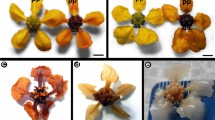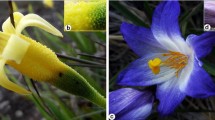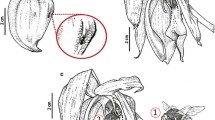Abstract
Malpighiaceae species are recognized for their sepal elaiophores of which secretions reward oil-collecting bees. Information on elaiophore location, structure and functioning is likely to provide valuable insights into pollination ecology and evolution of the family. We characterized the elaiophores in three Malpighiaceae species and compared the patterns of distribution and dimensions of these glands, their structural organization, their histochemistry and their life spans. Intact elaiophores from buds and 1-day flowers (bagged and un-bagged) of Banisteriopsis variabilis, Byrsonima coccolobifolia and Peixotoa reticulata were collected for structural, histochemical and ultrastructural studies. We also reported the behavior of elaiophore-visiting insects. Elaiophores exhibit uniseriate secretory epithelium covered by a thick cuticle and vascularized parenchyma. The secretory surfaces can be flat (B. coccolobifolia and P. reticulata) or convoluted (B. variabilis). In B. variabilis and P. reticulata the epithelium has longer cells than in B. coccolobifolia and these become papillose, taking an appearance similar to trichomal elaiophores. The mixed secretions accumulate within subcuticular spaces and may be released either by a natural rupture of the cuticle (B. coccolobifolia and P. reticulata) or by a sudden rupture caused by the bee activity (B. variabilis). Different bees were observed exploiting the elaiophores, acting as potential pollinators or oil robbers. A greater diversity of oil-collecting bees was registered in B. variabilis. The differences identified, mainly in relation to the location of the glands on the sepals, in the fine structure of secretory epithelia and cuticle architecture, and in their secretion release mechanisms, in some way, can affect the behavior of visitors.






Similar content being viewed by others
References
Aliscioni SS, Torretta JP, Bello ME, Galati BG (2009) Elaiophores in Gomesa bifolia (Sims) M.W. Chase & N.H. Williams (Oncidiinae: cymbidieae: Orchidaceae): structure and oil secretion. Ann Bot (Oxford) 104:1141–1149. doi:10.1093/aob/mcp199
Alves-dos-Santos I, Machado IC, Gaglianone MC (2007) História natural das abelhas coletoras de óleo. Oecol Brasil 11:544–557
Anderson WR (1979) Floral conservatism in Neotropical Malpighiaceae. Biotropica 11:219–223
Anderson WR (1981) Malpighiaceae. Mem New York Bot Gard 32:21–305
Anderson C (1982) A monograph of the genus Peixotoa (Malpighiaceae). Contr Univ Michigan Herb 15:1–92
Anderson WR (1990) The origin of the Malpighiaceae - The evidence from morphology. Mem New York Bot Gard 64:210–224
Anderson WR (2001) Malpighiaceae. In: Berry PE, Yatskievych K, Holst BK (eds) Flora of the Venezuelan Guayana, vol. 6. Missouri Botanical Garden Press, St. Louis, pp 82–185
Araújo JS, Meira RMSA (2016) Comparative anatomy of calyx and foliar glands of Banisteriopsis C. B. Rob. (Malpighiaceae). Acta Bot Brasil 30:112–123. doi:10.1590/0102-33062015abb0248
Buchmann SL (1987) The ecology of oil flowers and their bees. Annual Rev Ecol Syst 18:343–369. doi:10.1146/annurev.es.18.110187.002015
Cappellari SC, Haleem MA, Marsaioli AJ, Tidon R, Simpson BB (2011) Pterandra pyroidea: a case of pollination shift within Neotropical Malpighiaceae. Ann Bot (Oxford) 107:1323–1334. doi:10.1093/aob/mcr084
Cappellari SC, Melo GAR, Aguiar AJC, Neff JL (2012) Floral oil collection by male Tetrapedia bees (Hymenoptera: Apidae: Tetrapediini). Apidologie 43:39–50. doi:10.1007/s13592-011-0072-2
Carvalho PD, Borba EL, Lucchese AM (2005) Variação no número de glândulas e produção de óleo em flores de Stigmaphyllon paralias A. Juss. (Malpighiaceae). Acta Bot Brasil 19:209–214. doi:10.1590/S0102-33062005000200002
Castro MA, Vega AS, Múlgura ME (2001) Structure and ultrastructure of leaf and calyx glands in Galphimia brasiliensis (Malpighiaceae). Amer J Bot 88:1935–1944. doi:10.2307/3558420
Cocucci AA (1991) Pollination biology of Nierembergia (Solanaceae). Pl Syst Evol 174:17–35. doi:10.1007/BF00937691
Cocucci AA, Vogel S (2001) Oil producing flowers of Sisyrinchium species (Iridaceae) and their pollinators in southern South America. Flora 196:26–46. doi:10.1016/S0367-2530(17)30010-5
Cocucci AA, Holgado AM, Anton AM (1996) Estudio morfológico y anatómico de los eleóforos pedicelados de Dinemandra ericoides, Malpighiácea endémica del desierto de Atacama, Chile. Darwiniana 34:183–192. doi:10.14522/darwiniana.2014.341-4.404
Costa CBN, Costa JAS, Ramalho M (2006) Biologia reprodutiva de espécies simpátricas de Malpighiaceae em dunas costeiras da Bahia, Brasil. Revista Brasil Bot 29:103–114. doi:10.1590/S0100-84042006000100010
Cunha AR, Martins D (2009) Classificação climática para os municípios de Botucatu e São Manuel-SP. Irriga 14:1–11
Davies KL, Stpiczyńska M (2009) Comparative histology of floral elaiophores in the orchids Rudolfiella picta (Schltr.) Hoehne (Maxillariinae sensu lato) and Oncidium ornithorhynchum H.B.K. (Oncidiinae sensu lato). Ann Bot (Oxford) 104:221–234. doi:10.1093/aob/mcp119
Davis CC, Anderson WR (2010) A complete generic phylogeny of Malpighiaceae inferred from nucleotide sequence data and morphology. Amer J Bot 97:2031–2048. doi:10.3732/ajb.1000146
Davis CC, Schaefer H, Xi Z, Baum DA, Donoghue MJ, Harmone LJ (2014) Long-term morphological stasis maintained by a plant–pollinator mutualism. Proc Natl Acad Sci USA 111:5914–5919. doi:10.1073/pnas.1403157111
Douce R, Joyard J (1990) Biochemistry and function of the plastid envelope. Annual Rev Cell Biol 6:173–216. doi:10.1146/annurev.cb.06.110190.001133
Fahn A (1979) Secretory Tissues in Plants. Academic Press, New York
Gates B (1982) Banisteriopsis and Diplopterys (Malpighiaceae). Fl Neotrop Monogr 30:1–237
Holloway PJ (1982) Structure and histochemistry of plant cuticular membranes: an overview. In: Cutler DF, Alvin KL, Price CE (eds) The plant cuticle. Academic Press, London, pp 45–85
Johansen DA (1940) Plant michrotechnique. McGraw-Hill, New York
Karnovsky MJ (1965) A formaldehyde-glutaraldehyde fixative of high osmolarity for use in electron microscopy. J Cell Biol 27:137–138
Kunst L, Samuels AL (2003) Biosynthesis and secretion of plant cuticular wax. Progr Lipid Res 42:51–80. doi:10.1016/S0163-7827(02)00045-0
Laskowski LE, Bautista D (1999) Caracteristicas anatomicas de la flor del semeruco (Malpighia emarginata DC.). Ernstia 9:19–36
Lobreau-Callen D (1989) Les Malpighiaceae et leurs pollinisateurs. Coadaptation ou coévolution. Bull Mus Natl Hist Nat B Adansonia 11:79–94
Lorenzo E (1981) Sobre la inflorescencia, morfologia floral y embriologia de Janusia guaranitica (Malpighiaceae). Kurtziana 14:101–124
Machado IC (2004) Oil-Collecting bees and related plants: a review of the studies in the last twenty years and case histories of plants occurring in NE Brazil. In: Freitas BM, Pereira JOP (eds) Solitary bees: conservation, rearing and management for pollination. Imprensa Universitária, Fortaleza, pp 255–280
Mamede MCH (1993) Estudo comparativo de flores casmógamas, cleistógamas e de frutos de Camarea affins St. Hil. (Malpighiaceae). Acta Bot Brasil 7:21–31. doi:10.1590/S0102-33061993000100002
Mazia D, Brewer PA, Alfert M (1953) The cytochemical staining and measurement of protein with mercuric bromophenol blue. Biol Bull Mar Biol Lab Woods Hole 104:57–67
McManus JFA (1948) Histological and histochemical uses of periodic acid. Stain Technol 26:99–108
Mello MAR, Bezerra ELS, Machado IC (2013) Functional roles of Centridini oil bees and Malpighiaceae oil flowers in biome-wide pollination networks. Biotropica 45:45–53. doi:10.1111/j.1744-7429.2012.00899.x
Michener CD (2007) The bees of the world, 2nd edn. John Hopkins University Press, Baltimore
Neff JL, Simpson BB (1981) Oil-collecting structures in the Anthoporidae (Hymenoptera): morphology, function and use in systematics. J Kansas Entomol Soc 54:95–123
O’Brien TP, Feder N, McCully ME (1964) Polychromatic staining of plant cell walls by toluidine blue O. Protoplasma 59:368–373
Pacek A, Stpiczyńska M (2007) The structure of elaiophores in Oncidium cheirophorum Rchb.F. and Ornithocephalus kruegeri Rchb.F. (Orchidaceae). Acta Agrobot 60:9–14. doi:10.5586/aa.2007.024
Pacek A, Stpiczyńska M, Davies KL, Szymezak G (2012) Floral elaiophore structure in four representatives of the Ornithocephalus clade (Orchidaceae: Oncidiinae). Ann Bot (Oxford) 110:809–820. doi:10.1093/aob/mcs158
Paiva EAS (2016) How do secretory products cross the plant cell wall to be released? A new hypothesis involving cyclic mechanical actions of the protoplast. Ann Bot (Oxford). doi:10.1093/aob/mcw012
Paiva EAS, Machado SR (2006) Ontogênese, anatomia e ultraestrutura dos nectários extraflorais de Hymenaea stigonocarpa Mart. ex Hayne (Fabaceae – Caesalpinioideae). Acta Bot Brasil 20:471–482. doi:10.1590/S0102-33062006000200022
Paiva EAS, Oliveira DMT, Machado SR (2008) Anatomy and ontogeny of the pericarp of Pterodon emarginatus Vogel (Fabaceae, Faboideae), with emphasis on secretory ducts. Anais Acad Brasil Ci 80:455–465. doi:10.1590/S0001-37652008000300007
Pansarin LM, Castro MM, Sazima M (2009) Osmophore and elaiophores of Grobya amherstiae (Catasetinae, Orchidaceae) and their relation to pollination. Bot J Linn Soc 159:408–415. doi:10.1111/j.1095-8339.2009.00953.x
Pearse AGE (1980) Histochemistry theoretical and applied, vol. 2, 4th edn. Longman Press, London
Possobom CCF, Machado SR (2017) Elaiophores: their taxonomic distribution, morphology and functions. Acta Bot Brasil. doi:10.1590/0102-33062017abb0088
Possobom CCF, Guimarães E, Machado SR (2015) Structure and secretion mechanisms of floral glands in Diplopterys pubipetala (Malpighiaceae), a neotropical species. Flora 211:26–39. doi:10.1016/j.flora.2015.01.002
Rasmussen C, Olesen JM (2000) Oil flowers and oil-collecting bees. Skr Norske Vidensk-Akad Oslo Mat-Naturvidensk Kl 39:23–31
Reis MG, Faria AD, Alves-dos-Santos I, Amaral MCE, Marsaioli AJ (2007) Byrsonic acid - the clue to floral mimicry involving oil-producing flowers and oil-collecting bees. J Chem Ecol 33:1421–1429. doi:10.1007/s10886-007-9309-y
Renner SS, Schaefer H (2010) The evolution and loss of oil-offering flowers: new insights from dated phylogenies for plants and bees. Philos Trans Roy Soc London 365:423–435. doi:10.1098/rstb.2009.0229
Reynolds ES (1963) The use of lead citrate at high pH as an electron-opaque stain in electron microscopy. J Cell Biol 17:208
Sadala-Castilho R, Machado SR, Sá-Haiad B, Lima HA (2016) Oil-resin glands in Velloziaceae flowers: structure, ontogenesis and secretion. Pl Syst Evol 302:585–599. doi:10.1007/s00606-016-1287-5
Sass JE (1951) Botanical microtechnique. Iowa Press Building, Iowa
Sazima M, Sazima I (1989) Oil-gathering bees visit flowers and glandular morphs of the oil-producing Malpighiaceae. Bot Acta 102:106–111. doi:10.1111/j.1438-8677.1989.tb00073.x
Schmid KM, Ohlrogge JB (2002) Lipid metabolism in plants. In: Vance DE, Vance JE (eds) Biochemistry of lipids, lipoproteins and membranes. Elsevier, Amsterdam
Seigler D, Simpson BB, Martins C, Neff JL (1978) Free 3-acetoxyfatty acids in floral glands of Krameria species. Phytochemistry 17:995–996
Simpson BB (1982) Krameria (Krameriaceae) flowers: orientation and elaiophore morphology. Taxon 31:517–528
Simpson BB (1989) Pollination biology and taxonomy of Dinemandra and Dinemagonum (Malpighiaceae). Syst Bot 14:408–426
Simpson BB, Neff JL (1981) Floral rewards: alternatives to pollen and nectar. Ann Missouri Bot Gard 68:301–322
Steiner KE, Whitehead VB (2002) Oil secretion and the pollination of Colpias mollis (Scrophulariaceae). Pl Syst Evol 235:53–66. doi:10.1007/s00606-002-0216-y
Stern WS, Curry KJ, Pridgeon AM (1987) Osmophores of Stanhopea (Orchidaceae). Amer J Bot 74:1323–1331
Stpiczyńska M, Davies KL (2008) Elaiophore structure and oil secretion in flowers of Oncidium. Ann Bot (Oxford) 101:375–384. doi:10.1093/aob/mcm297
Stpiczyńska M, Davies KL, Gregg A (2007) Elaiophore diversity in three contrasting members of the Oncidiinae Benth. (Orchidaceae). Bot J Linn Soc 155:135–148. doi:10.1111/j.1095-8339.2007.00681.x
Subramanian RB, Arumugasamy K, Inamdar JS (1990) Studies in secretory glands of Hiptage sericea (Malpighiaceae). Nordic J Bot 10:57–62. doi:10.1111/j.1756-1051.1990.tb01753.x
Teixeira LAG, Machado IC (2000) Sistema de polinização e reprodução de Byrsonima sericea DC (Malpighiaceae). Acta Bot Brasil 14:347–357. doi:10.1590/S0102-33062000000300011
Vinson SB, Frankie GW, Williams HJ (1996) Chemical ecology of bees of the genus Centris (Hymenoptera: Apidae). Fla Entomol 79:109–129. doi:10.2307/3495809
Vinson SB, Williams HJ, Frankie GW, Shrum G (1997) Floral lipid chemistry of Byrsonima crassifolia (Malpighiaceae) and a use of floral lipid by Centris bees (Hymenoptera: Apidae). Biotropica 29:76–83. doi:10.1111/j.1744-7429.1997.tb00008.x
Vogel S (1974) Ölblumen und ölsammelnde Bienen. Trop Subtrop Pflanzenwelt 7:283–547
Vogel S (1990) History of Malpighiaceae in the light of pollination ecology. Mem New York Bot Gard 55:130–142
Acknowledgements
This manuscript is a part of the thesis of the first author (Programa de Pós-Graduação em Ciências Biológicas - Botânica, IBB/UNESP) and was supported by the Coordenação de Aperfeiçoamento de Pessoal de Nível Superior (CAPES) and Fundação de Amparo à Pesquisa do Estado de São Paulo (FAPESP BIOTA-08/55434-7 and DR-08/57650-9). The authors would like to thank the technicians of the Electron Microscopy Center (CME), IBB/UNESP, for laboratory assistance, Dr. M.C.H. Mamede for plant identification and Dr. A. Aguiar for bee identification.
Author information
Authors and Affiliations
Corresponding author
Additional information
Handling editor: Louis P. Ronse De Craene.
Rights and permissions
About this article
Cite this article
Possobom, C.C.F., Machado, S.R. Elaiophores in three Neotropical Malpighiaceae species: a comparative study. Plant Syst Evol 304, 15–32 (2018). https://doi.org/10.1007/s00606-017-1443-6
Received:
Accepted:
Published:
Issue Date:
DOI: https://doi.org/10.1007/s00606-017-1443-6




